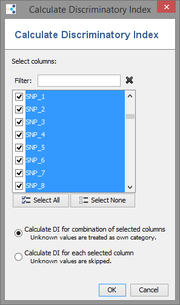The Discriminatory Index is calculated with the following formula:
<math>D=1 - \frac{1}{N(N-1)} \sum^s_{j=1}n_j(n_j-1)</math>
where <math>N</math> is the total number of Samples, <math>s</math> is the total number of types described, and <math>n_j</math> is the number of Samples belonging to the <math>j</math>th type.
Unknown values can either be ignored or treated as an unknown category.
A 95% Confidence Interval can be calculated with the following formula:
<math>CI=[D-2 \sqrt(\sigma^2), D+2 \sqrt(\sigma^2)]</math>
with
<math>\sigma^2=\frac{4}{N} [\sum \pi_j^3 - (\sum \pi_j^2)^2 ]</math> and
<math>\pi_j = \frac{n_j}{N}</math>.
See [Simpson, 1949], [Hunter, Gaston 1988], [Grundmann et. al. 2001].
References
Simpson, E.H.: Measurement of diversity, Nature 163:688, 1949
Hunter, P.R., and Gaston, M.A.: Numerical index of the discriminatory ability of typing systems: an application of Simpson’s index of diversity, J. Clin. Microbiol. 26:2465–2466, 1988
Grundmann, H., Hori, S., Tanner, G.: Determining confidence intervals when measuring genetic diversity and the discriminatory abilities of typing methods for microorganisms, J. Clin. Microbiol., 39:4190-4192, 2001
FOR RESEARCH USE ONLY. NOT FOR USE IN CLINICAL DIAGNOSTIC PROCEDURES.


